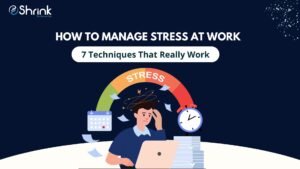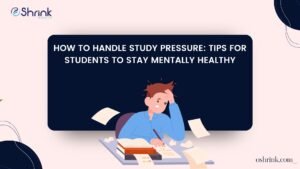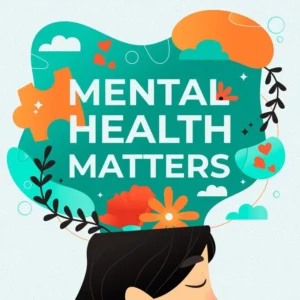Each panic attack provokes panic amongst those involved in this process, leaving a person helpless and overwhelmed. It could be due to stress, anxiety, or some underlying disorder. However, in order to regain control of the situation, it is important to know how to stop panic attacks at their core. In this guide, we’ll help you understand and navigate effective techniques and strategies to control panic attacks and provide relief both in the short and long term.
Being part of OShrink, a mental care platform, I understand that care for mental health is the need of the hour. This step-by-step guide will be able to walk you through the overwhelming moments of a panic attack, equipping you with practical methods to use before or after the attack and proactive measures to avoid it in the future.
What is a Panic attack?
Before we start to walk you through the techniques that help calm down during a panic attack, it is of vital importance that we all understand what is happening during one. A panic attack is an unexpected episode of intense fear or discomfort that reaches a peak within minutes. Some common symptoms include rapid heartbeat, shortness of breath, dizziness, chest pain, and sweating-chills; often with the feeling of losing control.
These episodes could take anything from a few minutes to half an hour, but the emotional impact of it is usually much more extended. Having knowledge about what a panic attack really is and why it happens can definitely help reduce fear around these episodes.
Step-by-Step Guide to Stop Panic Attacks
1. Practice Breathing Exercises for Anxiety Relief
Controlling your breath is one of the first skills you can master to end panic attacks. This technique can help counteract hyperventilation, which is extremely common in a panic attack and can heighten the overall sense of dizziness and terror. Slow, deep breathing can help desensitize your nervous system to stressful stimuli.
How to Practice Breathing Exercises for Anxiety Relief:
- Belly breathing: You shall take deep breaths through your nose, filling up your lungs and letting your stomach rise. Upon inhaling, let the stomach drop as you exhale slowly through your mouth.
- 4-7-8 Technique: Inhale for 4 seconds, hold the breath for 7 seconds, and then exhale slowly for 8 seconds. Do it a few times.
Breathing is proven to activate the body’s relaxation response, thus reducing the physical symptoms of anxiety and panic.
2. Grounding Techniques for Panic Attacks
Grounding techniques become quite helpful when one happens to feel derealized or overwhelmed. keeps your mind in the present moment; it hauls you away from that sort of anxiety wrought by the panic attack.
Effective Grounding Techniques:
- 5-4-3-2-1 Technique: Notice and identify five things you see, four things you can touch, three you can hear, two you can smell, and one you can taste. This calms you down and distracts you from the anxiety attack.
- Reach and grasp: Touch a textured object, an object with some firmness, such as a small stone or a piece of cloth, and focus on how that feels in your hand.
Grounding techniques distract your mind from the panic attack, which puts you more in control of your emotions.
3. Use Natural Remedies for Panic Attacks
Breathing and grounding techniques work effectively in the moment; however, long-term planning can help keep panic attacks from occurring too often and becoming overly intense. Many people are looking for solutions and get rapid relief through natural remedies; an excellent addition to your mental health equipment kit.
Common natural remedies:
- Herbal Teas: Chamomile and valerian root teas may help to soothe you when anxious
- Essential oils: lavender and peppermint can also be used to relax. There are quite a few ways of administration, from using the device called a diffuser to simply applying the diluted oils to your skin.
- Exercise: Generally, physical activity leads to decreases in the stress hormone cortisol and increases in the endorphin, which helps in improving the mood generally.
Such treatments are not to replace professional treatments, but they are rather relief during inter-treatment sessions or during high anxiety moments.
4. Self-Help Strategies for Anxiety Management
Day-to-day anxiety may reduce the frequency of panic attacks. In fact, the anticipation of working positively on self-help techniques builds emotional resilience and acts as a cushion against stress.
Practical Self-Help Strategies:
- Mindfulness meditation: Mindfulness practice helps you to become attuned to your thoughts and feelings and that will make you respond instead of reacting against pressures.
- Journaling: writing down thoughts, which may enable you to render meaning to emotions and clean up mental angst.
- Cognitive Behavioral Therapy (CBT): A systematic therapy for the purpose of teaching the patient to recognize and replace maladaptive thought patterns, health thinking patterns, and undesirable behavior.
Repeated utilization of these self-help therapies results in long-term anxiety management that may prevent a panic attack from even occurring in the first place.
5. Panic Attack Prevention Methods
Preventive measures in panic attacks can be developed if the early signs of stress and anxiety are foreseen. It signifies the grabbing of opportunities before the situation gets worse; this is largely facilitated by identifying possible triggers and developing coping mechanisms.
How to Prevent Panic Attacks
- Prevention of panic attacks: Trigger events: Identify those situations, environments, or thoughts that, from experience, appear to contribute to your current anxiety. When these trigger events are pinpointed, strategies can be devised to cope with them before they become a full-blown panic attack.
- Support system: Support from friends, family, or even a mental health professional in sharing the burden can make the person feel less isolated and more supported during the tough times.
- Healthy Habits: Maintain a healthy lifestyle through regular exercise, balanced dieting, and adequate sleep to manage mental conditions and minimize anxiety attacks.
Through daily practice, the above precautions can significantly reduce the frequency of panic attacks.
6. Techniques to Stop Anxiety Attacks at Work
One of the top causes of anxiety and panic attacks is work-related stress. Management of panic attacks in the workplace requires a readiness plan to regain composure immediately and be functional in a professional setting.
Workplace Strategies to Calm Down During a Panic Attack:
- Excuse yourself: If you are able to do so, take some time off and find a space that will be adequate for doing some deep breathing or grounding exercises.
- Use a stress ball or fidget tool: Something to focus on in the sense of physical can help your mind not dwell on panic that might be rising.
- Talk to a manager or HR: If you experience chronic anxiety in the workplace, talking over possible accommodations with a manager or HR can help minimize stressors that can trigger panic attacks.
Learning how to stop panic attacks in the workplace can retain productivity without sacrificing mental health.
7. Overcoming Panic Disorder Without Medication
Some people prefer to control panic disorder without medication; this is either due to personal preference or fear of side effects. Fortunately, there are many non-medication management strategies that can keep panic disorder under control.
Non-Medication Strategies:
- Psychotherapy: CBT has been found to be very effective in the management of panic disorder by bringing about a change in the disturbing thoughts which account for the person’s anxiety.
- Lifestyle changes: Regular physical activity, healthy diet, and good sleep hygiene can significantly reduce stress and calm the body and mind.
- Mind-body techniques: Yoga, Tai Chi, or progressive muscle relaxation can be used to calm the nervous system and provoke much less anxiety.
Given appropriate tools and support, panic disorder can well be managed without medication.
8. Emergency Tips for Panic Attacks
What to do when panic strikes You can help alleviate the crisis by knowing what to do when you get panicked. These emergency tips are here to provide instant relief whenever a panic attack hits you.
Quick Tips to Stop Panic Attacks:
- Focus on your breath: The 4-7-8 technique is just one form of breathing exercise aimed at regulating your breathing.
- Self-talk: Keep repeating to yourself that the panic will go away. Saying “this is temporary” helps your body feel less fear.
- Distraction: Count down from 100 or focus on something tangible like an object in your room to take your mind off of having a panic attack.
By having this handy toolkit of emergency tips, you can be in control when you have a panic and reduce its intensity as well.
Conclusion: Stop Panic Attacks with Effective Strategies
Knowing how to stop panic attacks would help you achieve a balanced approach to anxiety and to a healthy life. Amidst all of the breathing exercises, grounding techniques, self-help strategies, and natural remedies that can be use, there are indeed various ways to regroup and rebuild control over panic attacks. Panic attacks can be prevente if practiced frequently, but most importantly, it will help develop a healthier mindset.
At OShrink, we empower our members to take charge of their mental health. Reach out for professional help when anxiety or panic attacks overwhelm you. Your journey toward good mental wellness is guide through and through with the tools and resources on our platform.
To find more mental health tips and support management for panic attacks, visit- oshrink.com.
FAQs
Q- 1. What are the first signs of a panic attack?
Ans- The warning signs can include a sudden feeling of intense fear or anxiety, racing heartbeat, shortness of breath, dizziness, sweating, trembling, and a feeling of losing control. Identifying such pre-panic symptoms can enable one to take control sooner and regain calm before the full-blown panic attack.
Q- 2. Can panic attacks be completely prevented?
Ans- Although panic attacks can’t be completely prevente, there are different ways through which one can reduce the number of attacks and also its intensity. Calming practice, mindfulness, learning the triggers of the attacks, and professional support help abate and prevent the onset of panic attacks. Healthy lifestyle habits such as regular exercise and adequate sleep contribute to anxiety too.
Q- 3. How long does a panic attack last?
Ans- Panic attacks typically last from 5 to 20 minutes, but the peak of an attack occurs within a few minutes and the emotional aftermath can be much longer. But the most important thing to know is that panic attacks are just temporary, and people are indeed cured of them with the right methods and help.
Q- 4. Are there any long-term solutions for managing panic attacks?
Ans- For example, panics have long curing dimensions in that there is cognitive behavioral therapy that exposes one’s thought life to direct anxiety-producing patterns. Physical exercise, meditation and stress management, and upholding a healthy lifestyle can as well minimize the reoccurrence of panics over time.
Q- 5. Can breathing exercises really help stop a panic attack?
Ans- Breathing exercises are the most effective tools that can help to cease a panic attack. Hyperventilation usually aggravates the symptomatology of the panic attack; however, controlled breathing calms the body. Deep breathing, through techniques such as the 4-7-8 breathing method, reduces anxiety and prevents escalating symptomatology of a panic attack.






